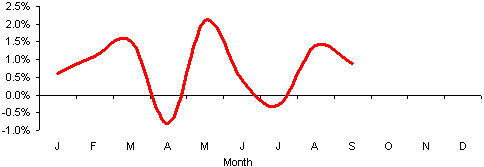Euro-Zone Retail Sales Reflect Softness
November 09, 05
Retail sales in the twelve Euro-Zone countries softened in September. While sales were up just under 1 percent over the same month a year ago, they were down from the prior month on a seasonally adjusted basis. These weak retail sales trends do not bode well, especially for jewelers, during the upcoming holiday selling season.
The graph below summarizes monthly retail sales trends in the 12 Euro-Zone countries of
| Euro-Zone Retail Sales Trends 2005 |
Retail sales in the 25 European Union countries rose by 1.4 percent, year-over-year, during September, but these statistics were skewed by dramatically stronger performance in developing countries such as
By category in Euro-Zone countries, consumables such as food, drinks, tobacco, newspapers, and books showed the weakest gains while textiles, footwear, and household goods showed solid gains.
Consumer demand remains the weakest link in the Euro-Zone recovery. Consumer sentiment is fragile, unemployment remains very high, and real wage growth lags. Thus, consumers are loath to part with their hard-earned cash.
The monthly retail sales figures are volatile and difficult to interpret. However, overall they are very weak: year-to-date Euro-Zone sales are up just over 1 percent versus
On a country-by-country basis, the following graph illustrates retail sales gains for the month of September. The countries are ranked largest to smallest (left-to-right) by number of households. It is notable that the largest Euro-Zone countries are posting some of the weakest sales gains.
September Retail Sales - Euro-Zone
Percent Change Year-to-Year
Source: EuroStat
